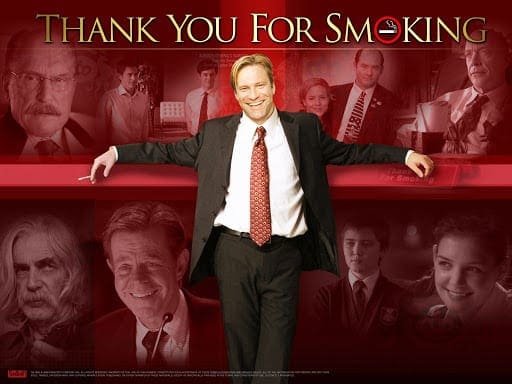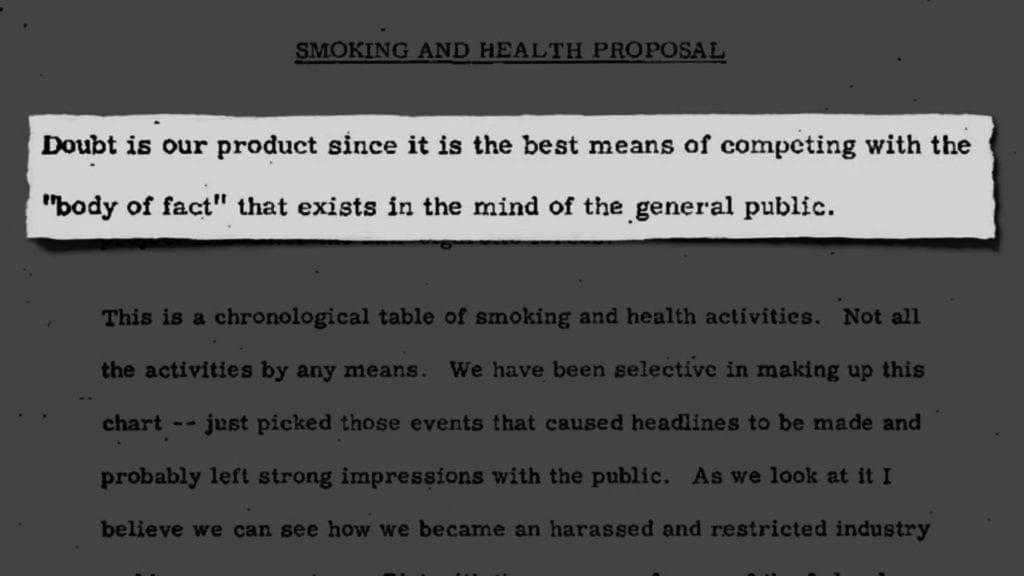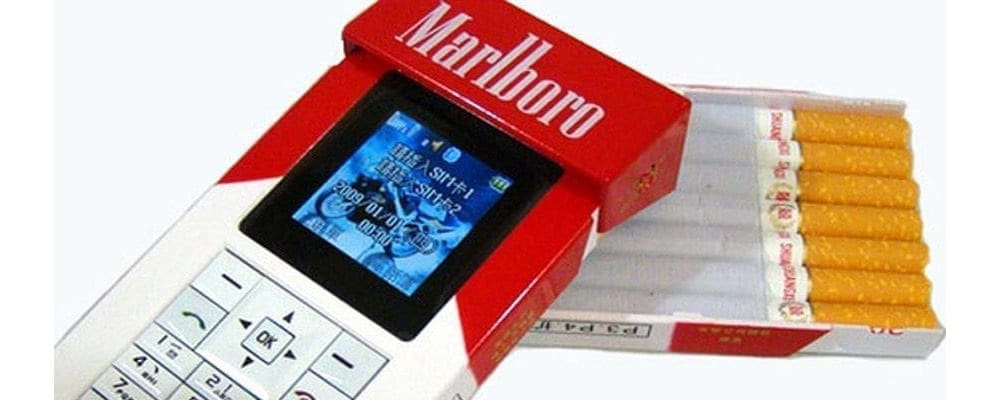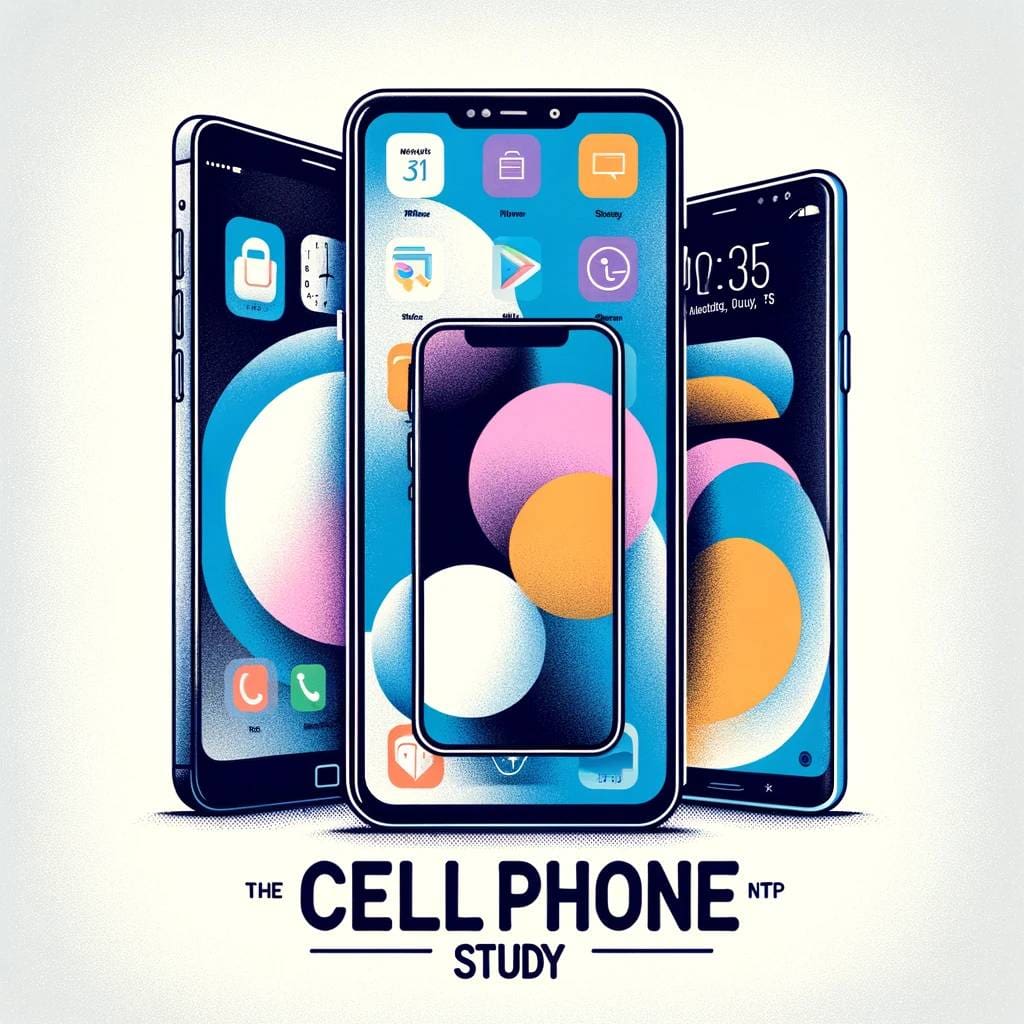If we’ve learned anything from other scandals like those surrounding “Big Tobacco” and “Big Oil” its that powerful industries employ powerful tactics to keep the public on their side. The same thing is happening with cell phones EMF radiation"Radiation" in the context of Electromagnetic Fields (EMF) refers to the process by which energy is emitted and transmitted through space or a material medium in the form of electromagnetic... science and safety regulations.
Cell Phones & Tobacco
In the film Thank You For Smoking, character Nick Naylor is a phenomenally successful lobbyist for the tobacco industry. An unpredictable set of circumstances, however, ruins his career. All seems lost until he has an epiphany—he realizes that he can transfer his skills to a new set of clients. At the close of the film, we see a rejuvenated Naylor advising a team of anonymous executives to repeat the following mantra to the media and the public:
Although we are constantly exploring the subject, currently there is no direct evidence that links cell phone usage to brain cancer.

That’s right– at the end of the movie, the consultant who is so expert at helping tobacco companies avoid liability finds a new life in the cell phone industry.
Now, this movie is a work of fiction. But it illustrates an obvious truth. The cell phone industry is using the tobacco playbook.
Big Wireless And The Economy Of Doubt
If we’ve learned anything from other scandals like those surrounding like “Big Tobacco” and “Big Oil” its that powerful industries employ powerful tactics to keep the public on their side.
Spreading doubt is one of them. To keep people buying a product you don’t necessarily need to convince them it’s safe — you just need to convince them there’s no conclusive evidence to the contrary.

Want to Slash Your EMF Health Risks?
Want to Slash Your EMF Health Risks?
Good! Learn the one small change you should make right now.
In 1969, the battle over the health effects of tobacco and cigarettes was still quite young. Some doctors and public health officials were starting to sound the alarm about the risks of smoking. But others, even doctors, disagreed, explaining there was no solid proof that cigarettes were harmful.
It was that same year that an executive of Phillip Morris wrote what has subsequently become an infamous memo:
Doubt is our product since it is our best means of competing with the “body of fact” that exists in the mind of the general public.

The tobacco industry didn’t set out to prove that cigarettes were healthy, or even just benign.
Instead, their primary strategy — and one that worked effectively for decades — was to cast doubt on the legitimacy of science. Because doubt is an effective weapon to fight facts. To put it another way, Big Tobacco couldn’t claim that cigarettes were good for health, but they were able to keep people smoking simply by casting doubt on the evidence they were bad.
(The tobacco playbook works so well, the NFL was even able to convince Congress, regulators, the media – and the entire country – that getting smashed in the head tens of thousands of times didn’t cause brain damage.)
“Big wireless” trades on the same economy of doubt. As long as the research results on the safety of electromagnetic radiationElectromagnetic radiation refers to the waves of the electromagnetic field, propagating through space, carrying electromagnetic radiant energy. It includes a wide range of electromagnetic waves, from very long radio waves... is conflicting, the public can’t be sure of the truth.
Going back to the example of Nick Naylor, you’ll note that he does not advise the executives to say that cell phone usage is safe. No, he encourages them to challenge the existence of any proven link. And this is frequently what we hear. Though some go so far as to claim that cell phones are completely non-toxic, statements more commonly claim there is no definitive proof of their harm.
In what ways do we see the tobacco playbook operate in the world of ‘big wireless’?
The United States National Toxicology Program Cell Phone Study
The National Toxicology Program (NTP) is a division of the US Department of Health and Human Services. The program was given funding to carry out a long-term animal study, in an attempt to assess the true health impacts of radio-frequency radiation in living beings.
Over the course of two years, the NTP cell phone study investigated the effects of cell phone radiation on rats and mice. The results released in February 2018 told us a lot.
But about what, exactly?
Rats and mice in the study were exposed to radio-frequency radiation for a total of around nine hours per day, over a period of two years. The NTP found some evidence of carcinogenic activity.
In particular, the report found a large increase in one type of malignant heart tumor in male rates, and an increase in heart tissue damage in both male and female rats. The same results did not apply to mice. Increases in other types of tumors, including brain, prostate, liver, and pancreas were statistically significant. Though the NTP says that, despite rigorous study conditions, these cancers could not be conclusively attributed to the cell phone radiation.
Because technology moves faster than health studies can keep up with, the NTP cell phone study only tested with 2G and 3G frequencies– even though telecommunications companies are actively deploying 5G technologies, which remain untested.
What the NTP Cell Phone Study Really Tells Us.
So how can the NTP study be interpreted? Well, that depends entirely on whom you ask.
If you ask Fast Company, “Government research shows link between cell phone radiation and tumors in rats.” But if you ask The Week, “Scientists finally agree that your phone won’t give you cancer.”
“Cell Phones Cause Cancer” says an NBC News affiliate in Lexington, Kentucky. “Cancer Risk From Cellphone Radiation Is Small,” says the New York Times.
This mass of conflicting news headlines highlights a real truth: the NTP cell phone study tells us more about the state of the industry than about actual science or health.
CNN hits the nail on the head with their news headline: “Cell phone radiation study finds more questions than answers.”
While it may not have been the intention of the NTP to muddy the waters further, their inconclusive study simply adds to the doubt. And the more doubt there is, the harder it is for real scientific fact to break through and enter the public consciousness.
“Doubt”, in other words, is the real result of the NTP study.
Selective Science
We see another example of the tobacco playbook in the 2012 report from the Mobile Telecommunications and Health Research Programme (MTHR). This study found “no evidence” of negative biological or health effects resulting from the use of mobile phones. The MTHR Programme Management Committee incorporated 31 separate research projects and it’s a fantastic example of misleading EMF science. ISPreview.com summarized the study:
People concerned that wireless radiationDefinition and Characteristics Wireless radiation refers to the electromagnetic radiation emitted by wireless devices and technologies. It encompasses a range of frequencies within the electromagnetic spectrum, typically from 300 MHz... from mobile services operating in the electromagnetic spectrumThe electromagnetic spectrum encompasses the entire range of electromagnetic radiation, which varies in wavelength and frequency. This spectrum includes, in order of increasing frequency and decreasing wavelength, radio waves, microwaves,... (radio), such as those used for Mobile Phones and Mobile Broadband (e.g. 900MHz and 1800MHz), can rest a little easier today after an 11-year long and £13.6m UK study found “no evidence” of biological or adverse health effects.
In short, this study concluded that there is “no evidence” of negative health effects from cell phone radiation. And the way they were able to generate these results is to mislead with science.
What I find most misleading in this summary, is that it makes it sound as though the included research studies are 11 years in duration. That does not seem to be accurate. It seems that this MTHR team worked for 11 years to compile multiple studies— but the studies themselves did not run for 11 years.
That’s a big difference.
In my review of research in this area, the vast majority of studies that examined 10 years or more of data have demonstrated correlation between EMF exposures and increased risk for cancerous outcomes. Such as this 2004 study, “Mobile Phone Use and the Risk of Acoustic Neuroma”.
As this 2010 San Francisco Gate article explains:
The 13 studies that investigated cell phone use for 10 or more years found a significant harmful association with tumor risk, especially for brain tumors, giving us ample reason for concern about long-term use.
So, while the MTHR Programme may have operated for 11 years, that does not mean each of these studies analyzed more than 10 years of data. As a result, the headline for the article that discusses the study (“11 Year MTHR Study Finds No Danger from Wireless Mobile Phone Radiation”) appears to be quite misleading.
The MTHR study, and the media coverage of it, confuse the duration of the research program, with the duration of the included studies.
This is an excellent example of how easy it is to manipulate the presentation of this very complex science, and why it is so important to dive into the details of studies and reports such as this, to attempt to discern some truth in the findings.
These are just two of many examples of how science is manipulated and distorted in the service of the wireless industry.
Who’s Funding The Research?
One of the most effective ways to determine the quality of science is to check who funded the specific research in question.
An in-depth investigative piece in The Nation magazine dug into the tactics used by Big Wireless to convince the public cell phones are safe. They point to another key method of manipulation: funding friendly research. This “conveys the impression that the scientific community truly is divided,” says the piece. “Thus, when studies have linked wireless radiation to cancer or genetic damage… industry spokespeople can point out, accurately, that other studies disagree.”
As a member of the public catching news reports on the latest research, it’s often near impossible to tell how a study was funded. The Nation recounts one professor who analyzed 326 safety-related studies into the biological effects of cell phone radiation. The results showed that about half the studies found negative effects while the other half didn’t. The scientific community seemed completely split.
But here’s where it gets interesting. When he redid the analysis to take funding sources into account, two-thirds of independent studies found a biological effect while only 28 percent of industry-funded studies did.
A 2007 study published in the journal Environmental Health Perspectives looked at the effect of funding sources on research outcomes, and landed on a similar conclusion. It found that industry-funded studies were two and a half times less likely to report a biological effect of EMF. “Results from studies of health effects of radiofrequency radiation,” conclude the authors, “should take sponsorship into account.”
The CDC and Cell Phone Health Risk: A Major Flip Flop
It’s not just the science that’s manipulated by big wireless. It’s also the work of health and regulatory agencies. Including the Centers for Disease Control (CDC).
In one example, on June 9, 2014, the Centers for Disease Control & Prevention became the first US government agency to issue a warning on cell phone usage, with an FAQ page that recommended a precautionary approach. Then, on August 20— and without any explanation— they reversed its position. There was a major flip flop with the CDC and cell phone health risks.
Joel Moskowitz from UC Berkeley, noted three changes made by the CDC in his August 20th press release, CDC Retracts its Precautionary Health Warning about Cell Phone Radiation.
For example, on June 9, the CDC FAQ page in question, answered the question “Can using a cell phone cause cancer?” by explaining:
There is no scientific evidence that provides a definite answer to that question. Along with many organizations worldwide, we recommend caution in cell phone use. More research is needed before we know for sure if using cell phones causes cancer. [Emphasis added.]
On August 20 however– just over two months later– the wording was changed to:
There is no scientific evidence that provides a definite answer to that question. Some organizations recommend caution in cell phone use. More research is needed before we know if using cell phones causes health effects.
One can speculate as to why the CDC reversed its position— and speculate is all one can do, since the CDC has provided no explanation. The Public News Service reports that Jim Turner, board chair of Citizens for Health and a public interest lawyer, “speculates the changes were triggered either by industry lobbyists, government officials, or both.. ‘Somebody alerted them [the CDC] that they wanted it down or there was going to be trouble.’”
The EPA & Cell Phone Health Risk
While the CDC may have been the first US government agency to issue a warning about cell phone health risks, it is not the first government agency to have issued language warning consumers about the risks of EMF radiation.
In the late 1980s, the risks of EMF was becoming an increasing concern, and the Office of Health and Environmental Assessment (OHEA) within the United States Environmental Protection Agency (EPA) began efforts to review the known science of health effects from non-ionizing EM radiation.
In March of 1990, the EPA released a draft of their findings; in this draft, the OHEA recommended that EMF should be designated amongst “probable human carcinogens.”
By 1991, however, when OHEA published their full report, such language had been removed from the document.
As my father, Dr. Martin BlankDr. Martin Blank, born in 1933, was a distinguished scientist and a leading expert in the field of electromagnetic fields (EMF). His groundbreaking research and advocacy made significant contributions to..., and I explain in his recent book, Overpowered:
the EPA explained that while it had some data indicating the health risks from cell phone radiation, it needed more specific proof before labeling EMF as carcinogenic.
In essence, this explanation mirrors the CDC’s revised language from August 20. We continue:
As an external observer, it is impossible to say what occurred behind the scenes to trigger the removal of this potentially-explosive language from its report. There can be no doubt, however, that the 1990 EPA draft coincided with an aggressive effort from the wireless industry to refute any such potential associations between cell phone radiation and negative health outcomes—particularly cancer—in humans. After all, the government was considering labeling its core products as carcinogenic.
Will we ever know why the CDC flip-flopped on the risks of cell phones? Maybe not. But this is not the first time that a US government agency tasked with protecting the public health has reversed itself on the health risks of wireless radiation.
This is how it works at the intersection of EMF science, public health and wireless industry profits.
The Changing Tide
Even as questions mount around the health risks of EMF radiation and wireless devices, the wireless industry continues to grow in power"Power" in a scientific context refers to the rate at which work is done or energy is transferred. In simpler terms, it's how fast something is using energy. For example,... and influence. According to a 2018 report, the U.S. wireless industry contributes $475 billion annually to America’s economy, and generates over $1 trillion in economic output.
That money creates a tremendous amount of power for these firms. And that power enables these firms to manipulate science and influence regulators. When science is cast in doubt, broad social understanding of health issues is delayed. And the regulations needed to improve health and safety are delayed.
But these are only delays: in time, the tide eventually changes.
That’s slowly but surely starting to happen with electromagnetic radiation. Awareness of the health risks of radiation exposure is dramatically increasing — particularly now with the deployment of 5G"5G" refers to the fifth generation of wireless communication technology, a step up from the previous 4G, 3G, and 2G networks. It's designed to provide faster internet speeds, more reliable... – as are governmental and regulatory responses.
As just two recent examples, France is looking to ban all cell phones in schools, and the California Department of Public Health has issued a warning to its citizens to stop carrying their phones in their pockets and sleeping next to them at night.
While public awareness of health risks still has a long way to go, these examples, along with a host of others, show that this tide is changing — and the tipping point isn’t far away.
Even the tobacco playbook only worked for so long.









